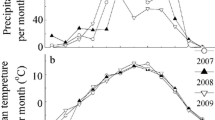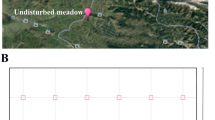Abstract
Rhinanthus minor L. is a root hemiparasite with known effects on community productivity and species composition. It is unclear, though, how these effects operate on functional trait composition and functional diversity. To fill this gap we established an experiment in a meadow community with a natural Rhinanthus population, where Rhinanthus presence (removal vs no removal) was manipulated under fertilized and unfertilized conditions. We assessed the biomass of individual species at the scale where plant individuals interact, in 20 cm × 20 cm plots. The community trait composition was characterized by community weighted means (CWM) and Rao’s quadratic entropy (as an index of functional diversity). Given the expected differences in the response to Rhinanthus parasitism, these parameters were computed for the whole community, for grasses (Poaceae family) and for forbs (non-leguminous dicots) separately. Generally, the species favoured by Rhinanthus were those with low competitive ability (with a low height, a low capacity for clonal growth, a taproot during the whole lifecycle, were monocyclic and had low leaf dry matter content). Rhinanthus increased functional diversity for clonality, which indicated a better coexistence of species with various capacities for clonal growth. CWM and functional diversity of grasses were not affected. Among the forbs, Rhinanthus mainly suppressed the tall, clonal species without a taproot (those which are functionally similar to grasses). Fertilization also affected CWM and functional diversity, but without significant interaction with Rhinanthus. We conclude that functional traits highlight the processes by which Rhinanthus affects vegetation structure and species coexistence.


Similar content being viewed by others
References
Ameloot E, Verheyen K, Hermy M (2005) Meta-analysis of standing crop reduction by Rhinanthus spp. and its effect on vegetation structure. Folia Geobot 40:289–310
Botta-Dukát Z (2005) Rao’s quadratic entropy as a measure of functional diversity based on multiple traits. J Veg Sci 16:533–540
Bullock JM, Pywell RF (2005) Rhinanthus: a tool for restoring diverse grassland? Folia Geobot 40:273–288
Cornelissen JHC, Pérez-Harguindeguy N, Díaz S, Grime JP, Marzano B, .Cabido M, Vendramini F, Cerabolini B (1999) Leaf structure and defence control litter decomposition rate across species and life forms in regional floras on two continents. New Phytol 143:191–200
Cornelissen JHC, Lavorel S, Garnier E, Díaz S, Buchmann N, Gurvich DE, Reich PB, ter Steege H, Morgan HD, van der Heijden MGA, Pausas JG, Poorter H (2003) A handbook of protocols for standardised and easy measurement of plant functional traits worldwide. Austral J Bot 51:335–380
Davies DM, Graves JD, Elias CO, Williams PJ (1997) The impact of Rhinanthus spp. on sward productivity and composition: Implications for the restoration of species-rich grasslands. Biol Conservation 82:87–93
de Hullu E (1985) The influence of sward density on the population dynamics of Rhinanthus angustifolius in a grassland succession. Acta Bot Neerl 34:23–32
Demey A, Staelens J, Baeten L, Boeckx P, Hermy M, Kattge J, Verheyen K (2013) Nutrient input from hemiparasitic litter favors plant species with a fast-growth strategy. Pl & Soil 371:53–66
Demey A, Rütting T, Huygens D, Staelens J, Hermy M, Verheyen K, Boeckxc P (2014) Hemiparasitic litter additions alter gross nitrogen turnover in temperate semi-natural grassland soils. Soil Biol Biochem 68:419–428
Demey A, De Frenne P, Baeten L, Verstraeten G, Hermy M, Boeckx P, Verheyen K (2015) The effects of hemiparasitic plant removal on community structure and seedling establishment in semi-natural grasslands. J Veg Sci 26:409–420.
R Development Core Team (2013) R: A language and environment for statistical computing. R Foundation for Statistical Computing. Vienna, Austria. Available at: http://www.R-project.org
Fibich P, Lepš J, Berec L (2010) Modelling the population dynamics of root hemiparasitic plants along a productivity gradient. Folia Geobot 45:425–442
Fortunel C, Garnier E, Joffre R, Kazakou E, Quested H, Grigulis K, Lavorel S, Ansquer P, Castro H, Cruz P, Doležal J, Eriksson O, Freitas H, Golodets C, Jouany C, Kigel J, Kleyer M, Lehsten V, Lepš J, Meier T, Pakeman R, Papadimitriou M, Papanastasis VP, Quetier F, Robson M, Sternberg M, Theau JP, Thebault A, Zarovali M (2009) Leaf traits capture the effects of land use changes and climate on litter decomposability of grasslands across Europe. Ecology 90:598–611
Gibson CC, Watkinson AR (1989) The host range and selectivity of a parasitic plant: Rhinanthus minor L. Oecologia 78:401–406
Hejcman M, Schellberg J, Pavlů V (2011) Competitive ability of Rhinanthus minor L. in relation to productivity in the Rengen Grassland Experiment. Pl Soil Environm 57:45–51
Johansson VA, Cousins SAO, Eriksson O (2011) Remnant populations and plant functional traits in abandoned semi-natural grasslands. Folia Geobot 46:165–179
Joshi J, Matties D, Schmid B (2000) Root hemiparasites and plant diversity in experimental grassland communities. J Ecol 88:634–644
Kazakou E, Violle C, Roumet C, Navas ML, Vile D, Kattge J, Garnier E (2014) Are trait-based species rankings consistent across data sets and spatial scales? J Veg Sci 25:235–247
Kleyer M, Bekker RM, Knevel IC, Bakker JP, Thompson K, Sonnenschein M, Poschlod P, van Groenendael JM, Klimeš L, Klimešová J, Klotz S, Rusch GM, Hermy M, Adriaens D, Boedeltje G, Bossuyt B, Dannemann A, Endels P, Gotzenberger L, Hodgson JG, Jackel AK, Kuhn I, Kunzmann D, Ozinga WA, Romermann C, Stadler M, Schlegelmilch J, Steendam HJ, Tackenberg O, Wilmann B, Cornelissen JHC, Eriksson O, Garnier E, Peco B (2008) The LEDA Traitbase: a database of life-history traits of the Northwest European flora. J Ecol 96:1266–1274
Kleyer M, Dray S, de Bello F, Lepš J, Pakeman R, Strauss B, Thuiller W, Lavorel S (2012) Assessing species and community functional responses to environmental gradients: which multivariate methods? J Veg Sci 23:805–821
Klimešová J, de Bello F (2009) CLO-PLA: the database of clonal and bud bank traits of Central European flora. J Veg Sci 20:511–516
Klimešová J, Klimeš L (2013) CLO-PLA3 – database of clonal growth of plants from Central Europe. Available at: http://clopla.butbn.cas.cz [Edition 3.3 December 2013]
Klimešová J, Latzel V, de Bello F, van Groenendael JM (2008). Plant functional traits in studies of vegetation changes in response to grazing and mowing: towards a use of more specific traits. Preslia 80:245–253
Kubát K, Hrouda L, Chrtek J jun, Kaplan Z, Kirschner J, Štěpánek J (2002) Klíč ke květeně České republiky (Key to the Flora of the Czech Republic). Academia, Praha
Lepš, J., & Těšitel, J. (2015). Root hemiparasites in productive communities should attack competitive host, and harm them to make regeneration gaps. J Veg Sci 26:407–408
Martínková J, Šmilauer P, Mihulka S (2002) Phenological pattern of grassland species: relation to the ecological and morphological traits. Flora 197:290–302
Matthies D (1995) Parasitic and competitive interactions between the hemiparasites Rhinanthus serotinus and Odontites rubra and their host Medicago sativa. J Ecol 83:245–251
Mudrák O, Lepš J (2010) Interactions of the hemiparasitic species Rhinanthus minor L. with its host plant community at two nutrient levels. Folia Geobot 45:407–424
Pavoine S, Vallet J, Dufour AB, Gachet S, Daniel H (2009) On the challenge of treating various types of variables: application for improving the measurement of functional diversity. Oikos 118:391–402
Phoenix GK, Press MC (2005) Linking physiological traits to impacts on community structure and function: the role of root hemiparasitic Orobanchaceae (ex Scrophulariaceae). J Ecol 93:67–78
Pinheiro J, Bates D, DebRoy S, Sarkar D (2012) nlme: Linear and nonlinear mixed effects models. R package version 3.1–104. Available at: https://cran.r-project.org/web/packages/nlme
Pywell RF, Bullock JM, Walker KJ, Coulson SJ, Gregory SJ, Stewenson MJ (2004) Facilitating grassland diversification using the hemiparasitic plant Rhinanthus minor. J Appl Ecol 41:880–887
Quested H, Eriksson O, Fortunel C, Garnier E (2007) Plant traits relate to whole-community litter quality and decomposition following land use change. Funct Ecol 21:1016–1026
Rowntree JK, Cameron DD, Preziosi RF (2011) Genetic variation changes the interactions between the parasitic plant-ecosystem engineer Rhinanthus and its hosts. Phil Trans, Ser B 366:1380–1388
Rowntree JK, Barham DF, Stewart AJA, Hartley SE (2014) The effect of multiple host species on a keystone parasitic plant and its aphid herbivores. Funct Ecol 28:829–836
Rümer S, Cameron DD, Wacker R, Hartung W, Jiang F (2007) An anatomical study of the haustoria of Rhinanthus minor attached to roots of different hosts. Flora 202:194–200
Ryser P (2006) The mysterious root length. Pl & Soil 286:1–6
Šmilauer P, Lepš P (2014) Multivariate analysis of ecological data using CANOCO 5, Cambridge University Press, Cambridge
ter Braak CJF, Šmilauer P (2012) Reference manual and user’s guide to Canoco for Windows: Software for Cannonical Community Ordination. Microcomputer Power, Ithaca
Těšitel J, Hejcman M, Lepš J, Cameron DD (2013) How does elevated grassland productivity influence populations of root hemiparasites? Commentary on Borowicz and Armstrong (Oecologia 2012). Oecologia 172:933–936
Těšitel J, Těšitelová T, Fisher JP, Lepš J, Cameron DD (2014) Integrating ecology and physiology of root-hemiparasitic interaction: interactive effects of abiotic resources shape the interplay between parasitism and autotrophy. New Phytol 205:350–360
van der Stoel CD, van der Putten WH, Duyts H (2002) Development of a negative plant–soil feedback in the expansion zone of the clonal grass Ammophila arenaria following root formation and nematode colonization. J Ecol 90:978–988
van Groenendael JM, Klimeš L, Klimešová J, Hendriks RJJ (1996) Comparative ecology of clonal plants. Philos Trans, Ser B 351:1331–1339
Westbury DB (2004) Rhinanthus minor L. J Ecol 92:906–927
Westoby M (1998) A leaf-height-seed (LHS) plant ecology strategy scheme. Pl & Soil 199:213–227
Westoby M, Leishman M, Lord J (1996) Comparative ecology of seed size and dispersal. Philos Trans, Ser B 351:1309–1317
Acknowledgements
This scientific article has been written during implementation of the project: ‘Integration of the experimental and population biology using new methods of interdisciplinary issues – the way to excellence with young scientists’, Reg.No.: CZ.1.07/2.3.00/30.0048, which is funded by the European Social Fund (ESF) and the state budget of the Czech Republic through the Operational Programme Education for Competitiveness (OPEC). This study was also supported by long-term research development project No. RVO 67985939. We are grateful to Dr. Brian G. McMillan for linguistic improvements and to two unknown reviewers for helpful comments on an earlier draft of the manuscript.
Author information
Authors and Affiliations
Corresponding author
Electronic supplementary material
Below is the link to the electronic supplementary material.
ESM 1
(PDF 352 kb)
Rights and permissions
About this article
Cite this article
Mudrák, O., de Bello, F., Doležal, J. et al. Changes in the functional trait composition and diversity of meadow communities induced by Rhinanthus minor L.. Folia Geobot 51, 1–11 (2016). https://doi.org/10.1007/s12224-016-9238-z
Received:
Accepted:
Published:
Issue Date:
DOI: https://doi.org/10.1007/s12224-016-9238-z




